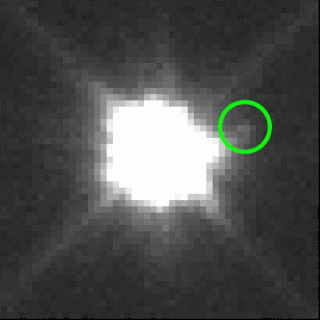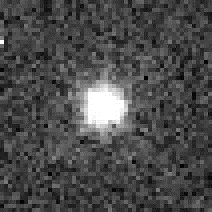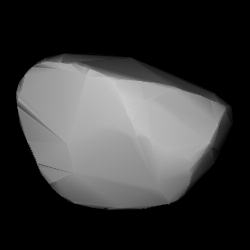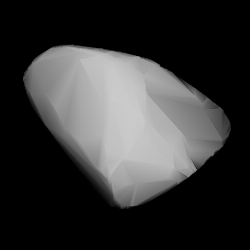Related Research Articles
3708 Socus (provisional designation: 1974 FV1) is a large Jupiter trojan from the Trojan camp, approximately 77 kilometers (48 miles) in diameter. It was discovered on 21 March 1974, by staff members of the Cerro El Roble Observatory owned and operated by the Department of Astronomy of the University of Chile. The assumed C-type asteroid has a rotation period of 6.55 hours. It was named after Socus, a hero from Greek mythology, who was killed in battle by Odysseus.
1749 Telamon is a dark Jupiter Trojan from the Greek camp, approximately 70 kilometers in diameter. It was discovered by German astronomer Karl Reinmuth at the Heidelberg Observatory on 23 September 1949, and named after Telamon from Greek mythology. The D-type asteroid is the principal body of the proposed Telamon family and belongs to the 60 largest Jupiter trojans. It has a rotation period of 17.0 hours and possibly a spherical shape.
3063 Makhaon is a large Jupiter trojan from the Greek camp, approximately 114 kilometers in diameter. It was discovered on 4 August 1983, by Soviet astronomer Lyudmila Karachkina at the Crimean Astrophysical Observatory in Nauchnij, on the Crimean peninsula. The dark D-type asteroid is the principal body of the proposed Makhaon family and belongs to the 20 largest Jupiter trojans having a rotation period of 8.6 hours. It was named after the legendary healer Machaon from Greek mythology.

3548 Eurybates is a carbonaceous Jupiter trojan from the Greek camp and the parent body of the Eurybates family, approximately 68 kilometers in diameter. It is a target to be visited by the Lucy mission in August 2027. Discovered during the second Palomar–Leiden Trojan survey in 1973, it was later named after Eurybates from Greek mythology. This C-type asteroid is among the 60 largest known Jupiter trojans and has a rotation period of 8.7 hours. Eurybates has one kilometer-sized satellite, named Queta, that was discovered in images taken by the Hubble Space Telescope in September 2018.
12714 Alkimos is a large Jupiter trojan from the Greek camp, approximately 54 kilometers in diameter. It was discovered on 15 April 1991, by American astronomer couple Carolyn and Eugene Shoemaker at the Palomar Observatory in California. The dark Jovian asteroid has a rotation period of 28.5 hours. It was named from Greek mythology after Alcimus, son of Ares and companion of Achilles.
37519 Amphios is a Jupiter trojan from the Trojan camp, approximately 33 kilometers in diameter. It was discovered at the Palomar Observatory during the third Palomar–Leiden Trojan survey in 1977. The dark Jovian asteroid is a member of an unnamed asteroid family and has a long rotation period of 50.9 hours. It was named after Amphius from Greek mythology.
1867 Deiphobus is a dark Jupiter trojan from the Trojan camp, approximately 123 kilometers (76 mi) in diameter. It was discovered on 3 March 1971, by Argentine astronomers Carlos Cesco and A. G. Samuel at the Leoncito Astronomical Complex in Argentina, and later named after the Trojan prince Deiphobus from Greek mythology. The dark D-type asteroid is one of the largest Jupiter trojans. It is a member of the Ennomos family and has a long rotation period of 58.66 hours.

4709 Ennomos is a large Jupiter trojan from the Trojan camp and the namesake of the small Ennomos family, approximately 81 kilometers in diameter. It was discovered on 12 October 1988, by American astronomer Carolyn Shoemaker at the Palomar Observatory in California. The relatively bright and possibly elongated Jovian asteroid belongs to the 40 largest Jupiter trojans and has a rotation period of 12.3 hours. It was named after Ennomus (Ennomos), a Trojan warrior killed by Achilles.
4007 Euryalos is a larger Jupiter trojan from the Greek camp, approximately 48 kilometers in diameter. It was discovered on 19 September 1973, by Dutch astronomers Ingrid and Cornelis van Houten at Leiden, and Tom Gehrels at Palomar Observatory in California. The likely spherical Jovian asteroid is the principal body of the proposed Euryalos family and has a rotation period of 6.4 hours. It was named after the warrior Euryalus from Greek mythology.

7119 Hiera is a large Jupiter trojan and potentially slow rotator from the Greek camp, approximately 70 kilometers in diameter. It was discovered on 11 January 1989, by American astronomer couple Carolyn and Eugene Shoemaker at Palomar Observatory in California. The dark Jovian asteroid belongs to the 60 largest Jupiter trojans and has an estimated rotation period of at least 400 hours. It was named for the Amazon Hiera, who fought against the Greeks in the Trojan War. As with 624 Hektor, the naming for this Jovian asteroid was placed into the wrong camp.
17492 Hippasos (provisional designation 1991 XG1) is a Jupiter trojan and member of the Ennomos family from the Trojan camp, approximately 54 kilometers (34 miles) in diameter. It was discovered on 10 December 1991, by astronomer Freimut Börngen at the Karl Schwarzschild Observatory in Tautenburg, Germany. The Jovian asteroid belongs to the 80 largest Jupiter trojans and has a rotation period of 17.8 hours. It was named after the Trojan prince Hippasus (Hippasos) from Greek mythology.
4791 Iphidamas is a Jupiter trojan from the Trojan camp, approximately 58 kilometers in diameter. It was discovered on 14 August 1988, by American astronomer Carolyn Shoemaker at the Palomar Observatory in California. The dark Jovian asteroid belongs the 100 largest Jupiter trojans and has a rotation period of 9.7 hours. It was named after the Trojan warrior Iphidamas, from Greek mythology.
4833 Meges is a large Jupiter trojan from the Greek camp, approximately 85 kilometers in diameter. It was discovered on 8 January 1989, by American astronomer Carolyn Shoemaker at the Palomar Observatory in California. The D-type asteroid belongs to the 40 largest Jupiter trojans and has a rotation period of 14.25 hours. It was named after Meges from Greek mythology.
2674 Pandarus is a large Jupiter trojan from the Trojan camp, approximately 98 kilometers in diameter. It was discovered on 27 January 1982, by astronomers at Harvard's Oak Ridge Observatory near Harvard, Massachusetts, in the United States. The likely elongated D-type asteroid has a rotation period of 8.48 hours and belongs to the 50 largest Jupiter trojans. It was named after Pandarus from Greek mythology.
4754 Panthoos is a Jupiter trojan from the Trojan camp, approximately 53 kilometers in diameter. It was discovered during the third Palomar–Leiden Trojan survey on 16 October 1977, by Ingrid and Cornelis van Houten at Leiden, and Tom Gehrels at the Palomar Observatory in California. It is likely spherical in shape and has a longer-than-average rotation period of 27.68 hours. The assumed C-type asteroid is one of the 80 largest Jupiter trojans. It was named after Panthous (Panthoos) from Greek mythology.

5283 Pyrrhus is a large Jupiter trojan from the Greek camp, approximately 65 kilometers in diameter. It was discovered on 31 January 1989, by American astronomer Carolyn Shoemaker at the Palomar Observatory in California. The dark Jovian asteroid belongs to the 100 largest Jupiter trojans and has a rotation period of 7.3 hours. It was named after Achilles son, Neoptolemus from Greek mythology.
4834 Thoas is a large Jupiter trojan from the Greek camp, approximately 86 kilometers in diameter. It was discovered on 11 January 1989, by astronomer Carolyn Shoemaker at the Palomar Observatory. The C-type asteroid is one of the 50 largest Jupiter trojans and has a rotation period of 18.19 hours. It was named after Thoas from Greek mythology.

4489 Dracius,, is a large Jupiter trojan from the Greek camp, approximately 90 kilometers in diameter. It was discovered on 15 January 1988, by American astronomer Edward Bowell at the Anderson Mesa Station of the Lowell Observatory near Flagstaff, Arizona, in the United States. The dark D-type asteroid belongs to the 50 largest Jupiter trojans and has a rotation period of 12.58 hours. It was named after Dracius from Greek mythology, who was a commander of the Epeans who fought against Hector.
5258 Rhoeo, provisional designation: 1989 AU1, is a Jupiter trojan and member of the Eurybates family from the Greek camp, approximately 53 kilometers (33 miles) in diameter. It was discovered on 1 January 1989, by Japanese astronomer Yoshiaki Oshima at the Gekko Observatory, east of Shizuoka, Japan. The assumed C-type asteroid belongs to the 90 largest Jupiter trojans and has a rotation period of 19.9 hours. It was named from Greek mythology after Rhoeo, lover of Apollo and mother of his son Anius.
7641 Cteatus, provisional designation: 1986 TT6, is a large Jupiter trojan from the Greek camp, approximately 70 kilometers (43 miles) in diameter. It was discovered on 5 October 1986, by Slovak astronomer Milan Antal at the Toruń Centre for Astronomy in Piwnice, Poland. The dark D-type asteroid is notably inclined and has longer-than-average rotation period of 27.8 hours. It belongs to the 50 largest Jupiter trojans. It was named from Greek mythology for Cteatus, the conjoined twin and father of Amphimachus.
References
- 1 2 3 4 5 "9799 (1996 RJ)". Minor Planet Center. Retrieved 5 June 2018.
- 1 2 3 "WGSBN Bulletin Archive". Working Group for Small Bodies Nomenclature. 14 May 2021. Retrieved 16 May 2021. (Bulletin #1)
- 1 2 3 4 "JPL Small-Body Database Browser: 9799 (1996 RJ)" (2018-05-24 last obs.). Jet Propulsion Laboratory . Retrieved 5 June 2018.
- 1 2 3 4 5 6 7 8 9 10 "LCDB Data for (9799)". Asteroid Lightcurve Database (LCDB). Retrieved 5 June 2018.
- ↑ "List of Jupiter Trojans". Minor Planet Center. 30 May 2018. Retrieved 5 June 2018.
- 1 2 3 "Asteroid (9799) 1996 RJ". AstDyS-2, Asteroids – Dynamic Site. Retrieved 5 June 2018.
- 1 2 "Asteroid (9799) 1996 RJ". Small Bodies Data Ferret. Retrieved 5 June 2018.
- 1 2 Rozehnal, J.; Brož, M. (July 2014). "Long-term evolution of asteroid families among Jovian Trojans". Asteroids: 452. Bibcode:2014acm..conf..452R.
- 1 2 3 Tedesco, E. F.; Noah, P. V.; Noah, M.; Price, S. D. (October 2004). "IRAS Minor Planet Survey V6.0". NASA Planetary Data System – IRAS-A-FPA-3-RDR-IMPS-V6.0: IRAS-A-FPA-3-RDR-IMPS-V6.0. Bibcode:2004PDSS...12.....T . Retrieved 15 June 2018.
- 1 2 3 4 Grav, T.; Mainzer, A. K.; Bauer, J. M.; Masiero, J. R.; Nugent, C. R. (November 2012). "WISE/NEOWISE Observations of the Jovian Trojan Population: Taxonomy". The Astrophysical Journal. 759 (1): 10. arXiv: 1209.1549 . Bibcode:2012ApJ...759...49G. doi:10.1088/0004-637X/759/1/49. S2CID 119101711. (online catalog)
- 1 2 3 4 Usui, Fumihiko; Kuroda, Daisuke; Müller, Thomas G.; Hasegawa, Sunao; Ishiguro, Masateru; Ootsubo, Takafumi; et al. (October 2011). "Asteroid Catalog Using Akari: AKARI/IRC Mid-Infrared Asteroid Survey". Publications of the Astronomical Society of Japan. 63 (5): 1117–1138. Bibcode:2011PASJ...63.1117U. doi: 10.1093/pasj/63.5.1117 . (online, AcuA catalog p. 153)
- 1 2 Mottola, Stefano; Di Martino, Mario; Erikson, Anders; Gonano-Beurer, Maria; Carbognani, Albino; Carsenty, Uri; et al. (May 2011). "Rotational Properties of Jupiter Trojans. I. Light Curves of 80 Objects". The Astronomical Journal. 141 (5): 32. Bibcode:2011AJ....141..170M. doi: 10.1088/0004-6256/141/5/170 .
- ↑ Veres, Peter; Jedicke, Robert; Fitzsimmons, Alan; Denneau, Larry; Granvik, Mikael; Bolin, Bryce; et al. (November 2015). "Absolute magnitudes and slope parameters for 250,000 asteroids observed by Pan-STARRS PS1 - Preliminary results". Icarus. 261: 34–47. arXiv: 1506.00762 . Bibcode:2015Icar..261...34V. doi:10.1016/j.icarus.2015.08.007. S2CID 53493339.
- 1 2 3 Nesvorný, D.; Broz, M.; Carruba, V. (December 2014). "Identification and Dynamical Properties of Asteroid Families". Asteroids IV. pp. 297–321. arXiv: 1502.01628 . Bibcode:2015aste.book..297N. doi:10.2458/azu_uapress_9780816532131-ch016. ISBN 9780816532131. S2CID 119280014.
- ↑ "MPC/MPO/MPS Archive". Minor Planet Center. Retrieved 5 June 2018.